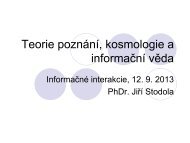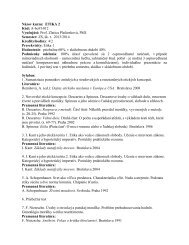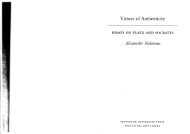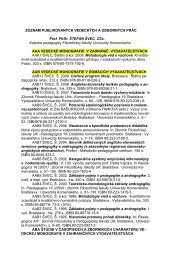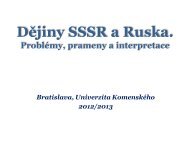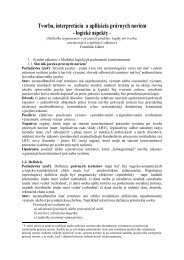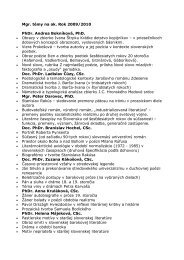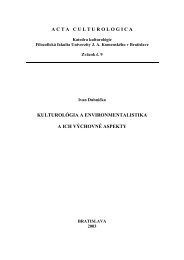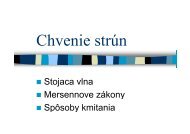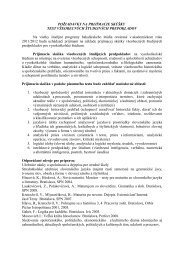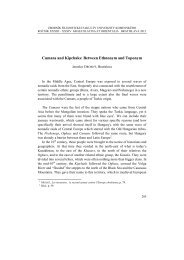Create successful ePaper yourself
Turn your PDF publications into a flip-book with our unique Google optimized e-Paper software.
112 LEXICAL MEA ING<br />
are not strictly substitutable because the sentences in (lO) would not be equally<br />
appropriate in all ocia1 contexts.<br />
(10) a.<br />
b.<br />
c.<br />
Where is the john?<br />
Where i the lavatory?<br />
Where is the powder room?<br />
John, la vato ry, <strong>and</strong> powder room are sense synonyms because they denote the<br />
same things, but because they differ in register <strong>and</strong> connotation, they are variants<br />
of one another. Synonyms can be variants with respect to any number of nondenotational<br />
properties, including connotation, register, dialect, <strong>and</strong> affect. The<br />
American sense of bathroom (which can refer to a room with a toilet but no ba th)<br />
<strong>and</strong> British 100 (which refer to a room with a toilet) are ense near-synonyms,<br />
but dialectal variants.<br />
Why so many synonyms?<br />
The moral of the synonym story is that it is very rare for two words to mean<br />
exactly the ame thing. As Cruse (1986:270) has noted, "languages abhor ab olute<br />
synonyms just as nature abhors a vacuum." English has many near-synonyms<br />
because it has readily borrowed words from other languages <strong>and</strong> because English<br />
productively makes new open-class word through the morphological processes<br />
of derivation <strong>and</strong> compounding (§1.3.4) <strong>and</strong> conversion (§5.3.2).<br />
In some case , those new or borrowed word tart out a perfect ynonym<br />
for existing words in the language, but over time one of two things generally<br />
happens. In some cases one of the ynonym "wins" <strong>and</strong> the other drop out of<br />
use. For example, the Greek-derived Eucharist began to replace the Old English<br />
husi toward the end of the Middle Age, <strong>and</strong> now husl is obsolete. In other ca e ,<br />
the words' senses diverge. A famous example is what happened when Norman<br />
French words for certain live tock animals were borrowed into Engli h in the<br />
Middle Ages. Before that point, Engli h speakers had words for these animals<br />
<strong>and</strong> used them also to describe meat from those animals; so they ate ox or sheep or<br />
pig fiesh. After the French words for livestock became available, Engli h peakers<br />
came to use the French livestock word (which became anglicized a beef, mutton,<br />
pork) to refer to meat, while the native English words were retained for denoting<br />
the animal. Other animal words were not affected by French borrowings, either<br />
because the French word was not popularized in English (in the case of lamb)<br />
or because the word was added to the language later (in the ca e of turkey).<br />
Synonyms are also found in ca e where one word i reserved for technical<br />
registers while the other sounds more folksy or poetic. For example, the Latinate<br />
uterus is a more "medical" sounding word than womb, which is more likely to<br />
be used in poetry.<br />
Languages react to ynonyms in this way for a number of reason . First, it i<br />
not economical or helpful to have many word for the ame thing - it takes more<br />
effort to learn <strong>and</strong> remember two word form when one i sufficient. When we go<br />
through the effort of having two words, we usually work under the a sumption<br />
of a principIe of contrast - ti<br />
different meanings. This mean<br />
the same thing as another WOl<br />
di fference - in denotation, conn<br />
Clark <strong>and</strong> Clark (1979) give ex<br />
noun into verbs results in a nl<br />
for fo cook <strong>and</strong> to che! in (ll):<br />
(Il) a.<br />
b.<br />
Phil cooked up a fea I<br />
Phil chef'd up a feast.<br />
To cook is an established verb,<br />
denotes the ame activity a lo<br />
a little different than cook. For<br />
more professionalism or panacJ<br />
In um mary, while language<br />
words that are very close in n<br />
can be seen as enriching, rathei<br />
is aid to be particularly syna<br />
more expressive than language<br />
in meaning can be conveyed a<br />
paralinguistic (e.g. intonational<br />
6.2.3 Hyponymy <strong>and</strong> h~<br />
Another type of pan<br />
or are contained in, other mee<br />
extension (§2.3. J) of one word ii<br />
the extension of cheddar ia'<br />
i cheddar is al o cheese, but ev<br />
( ince it could be gouda or mo<br />
cheddar is a type of cheese, a:<br />
meaning of cheddar.<br />
Properties of inch<br />
The inclusion relation is asynu<br />
is not a type of cheddar, o we I<br />
relation: cheddar is a hyponyn<br />
dar. The e terms come from the<br />
over,' <strong>and</strong> this under/over inu<br />
a "family trees," as illustrated<br />
ification, or taxonomy, of foc<br />
peaking, we use the terms hy!<br />
<strong>relations</strong> between words like c<br />
cheddar itself, or the nation of (



